At WiseGEEK, we're committed to delivering accurate, trustworthy information. Our expert-authored content is rigorously fact-checked and sourced from credible authorities. Discover how we uphold the highest standards in providing you with reliable knowledge.
What Is a Sterile Vial?
A sterile vial is a container used for sample collection where aseptic protocols are enforced. Sterile vials are manufactured using sterile equipment and techniques and sealed to prevent contamination. There are many different types of sterile vials, but the most common are small, glass containers sealed with a rubber stopper and aluminum lid.
In a hospital setting or research facility where sterilization is a priority, a sealed sterile vial is generally used for collecting blood or plasma samples. When using one of these vials, a sterile syringe is used to collect the sample and the needle on the syringe is inserted directly into the lid of the sterile vial. The laboratory technician responsible for sterile sample collection and processing should wear appropriate gloves during the sample collection process.

Sterile vials and bottles come in a variety of sizes and colors to accommodate a wide range of needs in the industry. Most manufacturers offer a sterile vial as small as 1 milliliter (mL) up to 100 mL. A sterile vial is generally made out of borosilicate or glass, as is most sterile lab equipment. The glass can be clear or — if there is a need to protect the contents from light — amber in color.

Depending on the sample collection method, there may be a specific type of cap required. While a rubber stopper and cap are a common configuration, there also are threaded screw tops, colored caps and cork-stopped vials. Caps for sterile vials may be sold separately, depending on the manufacturer and type of sterile vial.
For environmental sample collection, a different type of sterile vial may be used. These vials are tubes with a flat bottom and they come in clear or amber glass. In terms of volume, environmental vials are generally designed to hold 20, 40 or 60 mL. Environmental scientists may use such vials to collect water samples, insects and other field samples to take back to a laboratory for analysis.

A certificate of sterility and a unique lot number should accompany any sterile equipment order placed with a reputable manufacturer. The best sterilization practices may include a completely hands-free production line using robotic equipment and video monitoring. Sample containers that have gone through a rigorous sterilization process are essential for preventing contamination and other damage to the contents within each sterile vial.
AS FEATURED ON:
AS FEATURED ON:














Discuss this Article
Post your comments